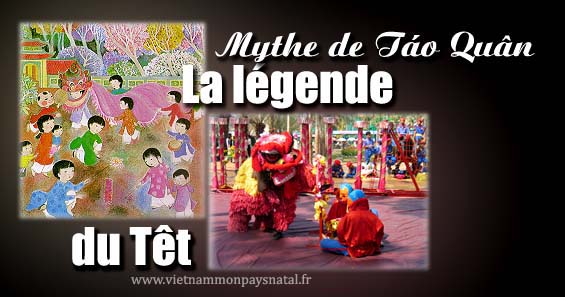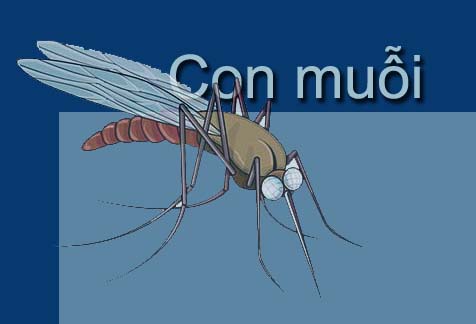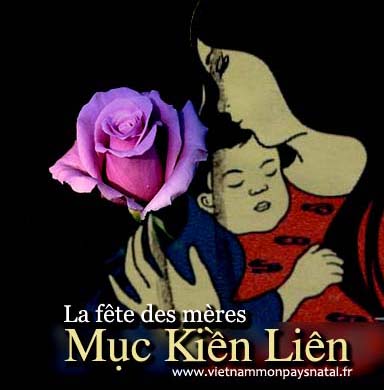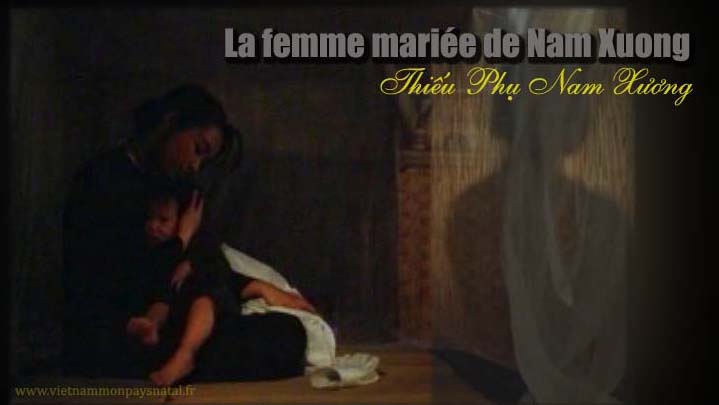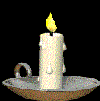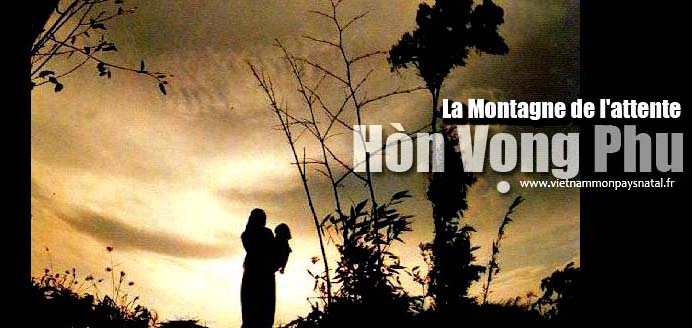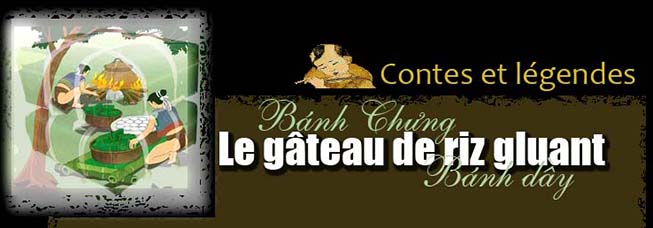Le mythe de Táo Quân
Le mythe des génies du foyer repose sur la tragique histoire d’un bûcheron et de sa femme. Il prend sa source dans le taoïsme. Ce couple modeste vivait heureux jusqu’au jour où il découvrit qu’il ne pouvait pas avoir d’enfants. L’infortuné mari se mit à boire et à maltraiter sa femme. Celle-ci ne pouvant en supporter davantage le quitta et épousa un chasseur d’un village voisin. Mais un jour, fou de solitude et plein de remords, le bûcheron décida de rendre visite à sa femme pour lui présenter ses excuses.
Sur ces entrefaites, le chasseur rentra chez lui. Afin d’éviter tout malentendu, la jeune femme cacha son premier mari dans une étable au toit de chaume, située près de la cuisine où le chasseur était en train de fumer son gibier. Par malheur, une braise s’échappa du foyer et mit le feu à l’étable.
Affolée, la jeune femme s’élança vers l’étable en flammes pour sauver son ex-époux. Le chasseur la suivit pour lui porter secours et tous trois périrent dans le brasier. L’empereur de Jade (Ngọc hoàng), du haut de son trône céleste, profondément touché par ce triste sort, divinisa les trois malheureux et les chargea de veiller au bien-être des Vietnamiens à l’emplacement avantageux de la cuisine. C’est ainsi qu’ils devinrent dès lors les génies du Foyer.
Pendant la semaine où les génies sont au ciel, les Vietnamiens craignent que leur maison soit sans protection. Afin de prévenir toute incursion des mauvais esprits dans leur maison, ils érigent devant chez eux une haute perche de bambou (cây nêu) sur laquelle sont suspendues des plaques en argile (ou khánh en vietnamien) vibrant avec sonorité au gré du vent pour éloigner les esprits. Au sommet de cette perche, flotte un morceau de tissu jaune marqué par l’emblème bouddhique.
Cette coutume trouve ses origines dans une légende bouddhique intitulée « Le Tết du bûcheron » selon laquelle les Vietnamiens doivent affronter des esprits maléfiques.
C’est toujours le vingt-troisième jour du dernier mois lunaire que chacun des Vietnamiens organise une cérémonie de départ du génie de foyer pour le ciel. On trouve non seulement sur son autel des fruits, des mets délicieux, des fleurs mais aussi un équipement de voyage approprié (3 paires de bottes, 3 chapeaux, vêtements, des papiers votifs) et des trois carpes mises dans une petite cuvette. À la fin de la cérémonie, on brûle les papiers votifs et on libère les carpes dans un étang ou dans une rivière afin que le génie puisse s’en servir pour s’envoler au ciel. Celui-ci doit rapporter tout ce qu’il a vu sur terre à l’empereur de jade, en particulier dans le foyer de chaque Vietnamien. Son séjour dure ainsi six jours au ciel. Il doit retourner au foyer dans la nuit du réveillon jusqu’au moment où débute la nouvelle année.
(*) cây nêu: C’est un arbre cosmique reliant la terre au ciel en raison des croyances des peuples anciens adorant le soleil, y compris les Proto-Vietnamiens mais il est employé également pour délimiter leur territoire.
Truyền thuyết về các Táo quân được dựa trên câu chuyện bi thảm của một người thợ rừng và vợ của ông ta. Nó có nguồn gốc từ Lão giáo. Cặp vợ chồng khiêm tốn này được sống hạnh phúc cho đến khi họ phát hiện ra rằng họ không thể có con. Người chồng bất hạnh nầy mới bắt đầu rượu chè và ngược đãi bà vợ. Bà nầy không thể chịu đựng được nữa và rời bỏ ông ta và kết hôn với một người thợ săn ở làng bên cạnh. Nhưng một ngày nọ, cô đơn và hối hận, người thợ rừng quyết định đến thăm vợ để xin tạ lỗi.
Giữa lúc đó, người thợ săn trở về nhà. Để tránh mọi sự hiểu lầm, người phụ nữ trẻ buộc lòng giấu người chồng cũ của mình ở trong một chuồng gia súc có mái nhà bằng tranh, nằm gần nhà bếp nơi mà người thợ săn đang hun khói thịt rừng. Thật không may, một đóm lửa than hồng thoát ra khỏi lò và đốt cháy chuồng.
Cùng quẫn, người phụ nữ trẻ lao mình về phía chuồng đang bốc cháy để cứu chồng cũ. Người thợ săn chạy theo cô để giúp cô và cả ba đã chết trong ngọn lửa. Ngọc Hoàng, từ trên cao nhìn xuống, cảm động vô cùng trước số phận đau buồn này, phong thần cho ba người và buộc họ phải trông chừng từ đây hạnh phúc của người dân Việt ở vị trí thuận lợi của nhà bếp. Bởi vậy họ trở thành các thần bếp núc từ đây của các gia đình người Việt.
Trong tuần lễ các táo quân ở trên trời, người Việt lo sợ ngôi nhà của họ sẽ không được bảo vệ. Để ngăn chặn sự xâm nhập của tà ma vào nhà, họ dựng trước cửa nhà một cây nêu có treo những khánh đất phát tiếng động khi có gió rung. Trên đỉnh cột này có treo một mảnh vải màu vàng có biểu tượng của Phật giáo.
Phong tục này bắt nguồn từ một truyền thuyết Phật giáo mang tên « Tết của người thợ rừng », theo đó người dân việt phải đối mặt với những linh hồn ma quỷ.
Cứ đến ngày hai mươi ba tháng Giêng âm lịch, mỗi người dân Việt lại tổ chức lễ tiễn Táo quân về trời. Không chỉ có trái cây, thức ăn ngon, các bông hoa trên bàn thờ của Táo quân mà còn có đồ dùng cho cuộc hành trình thích hợp (3 đôi giầy, 3 cái mũ, 3 bộ đồ quần áo, vàng mã) và ba con cá chép được đặt trong một chiếc thau nhỏ. Sau khi kết thúc lễ cúng thì đốt vàng mã và thả cá chép xuống ao hay sông để Táo quân mượn cá chép bay về trời. Táo quân phải báo cáo lại với Ngọc Hoàng tất cả những gì Táo quân được nhìn thấy ở trần gian, nhất là ở trong nhà của mỗi gia đình của người dân Việt. Thời gian lưu trú của Táo quân được kéo dài là sáu ngày ở trên trời. Táo quân phải trở về nhà vào đêm giao thừa đúng lúc khi năm mới vừa bắt đầu.
(*) cây nêu: cây vũ trụ nối liền đất với trời, do tín ngưỡng thờ thần mặt trời của các dân tộc cổ mà trong đó có người Việt cổ mà còn hàm chứa ý thức về lãnh thổ cư trú của họ.

